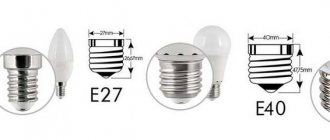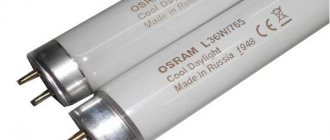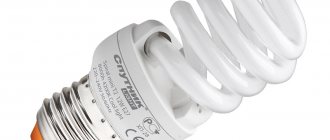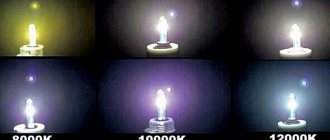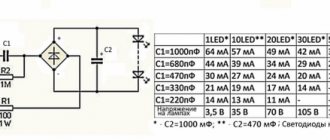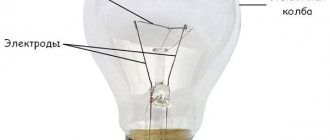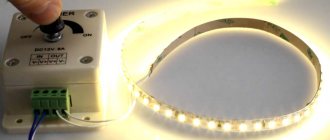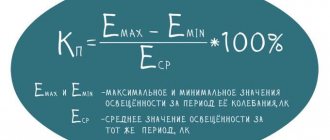Light flow
One of the most important characteristics of e27 is luminous flux. This is the power of light emission. This parameter is measured in Lumens (Lm). The intensity of lighting depends on it. Characterizing filament light sources, the luminous flux is, as a rule, rarely used. Their power is usually measured in Watts.
For LED analogues, the ratio of the luminous flux to the power consumed by this device reflects their economy or efficiency. It is measured in Lm/W. Thanks to the luminous flux, you can choose an LED analogue of a conventional incandescent lamp.
For what types of lamps is the E27 socket suitable?
Lighting equipment differs not only in cartridges. Technical characteristics are important: voltage, power and permissible temperature values. In accordance with this information, certain lamps are selected.
The only problem that can be easily solved is the diameter of the screw base. Manufacturers offer a variety of adapters to choose from. True, then the socket will be lengthened, and the light bulb will stand out more from the shade. But everything will work properly.
Adapter from E14 to E27
If you make a mistake in choosing the type of lamp, you can make a mistake with the heating and the cartridge will begin to melt. Incorrect voltage will lead to failure of any device.
Incandescent lamp
The classic type of lamps with a tungsten or carbon filament inside occupies a leading position in popularity. The main reason for this is the low price. The technical specifications are as follows:
- luminous flux about 9-19 Lm/W;
- power from 25 to 150 W;
- voltage can be 230 and 380V;
- durability is approximately 1000 hours;
- yellow color.
You might be interested in Using programs to calculate lighting
The lamp turned black over time
However, in the modern market, incandescent lamps are noticeably inferior to other analogues.
Important! The threads heat up to 2-3 thousand degrees Celsius, which is why plastic cartridges often melt from heating. During operation, vapors are generated inside the flask, which leads to clouding of the glass. As a result, the level of illumination decreases.
In the group of incandescent lamps, there are several separate types. Reflector devices with internal silver coating are used when directional light is needed. To create a bright environment, use illumination lamps coated inside or outside the bulb with inorganic pigments. It is worth noting that the power can reach only 10-25 W.
Pigmented lamps
For designer lighting, manufacturers offer to install decorative products. It is distinguished by the shape of a transparent flask and large spirals of threads inside.
Halogen
This type of lamp is improved by the presence of halogen vapor in a vacuum of a smaller bulb. At the same time, the power is increased by 2 times. Tungsten filament lasts from 2000 to 5000 hours. In this case, the luminous flux has an indicator of 17-20 Lm/W. Products that are supplemented with bromine or iodine illuminate approximately 10 Lm/W stronger. The operating voltage can be either 220V or 12V.
Energy saving
Fluorescent lamps consume 5 times less energy than conventional lamps. That is, emitting daylight (white) or yellow light with a power of 25 to 600 W will take 5 and 120 W, respectively. The luminous flux is 44-70 Lm/W.
Energy saving lamp e27
The service life is 1000-15000 hours. But there is an opinion that frequent connection and breakage of contacts leads to a reduction in these indicators. During the glow, ultraviolet radiation is released, which sometimes negatively affects human health.
The features of energy-saving lamps include 2 points. The first is to set the color. This takes from 3 to 120 seconds. The second nuance is flicker. If this happens, it means the device will soon fail. Application has restrictions regarding temperature. Light bulbs should not be used at temperatures below −15 degrees Celsius.
Important! It is worth noting the presence of phosphorus and mercury. If the flask breaks, the room should be ventilated immediately and the fragments should be removed immediately.
You may be interested in Features of illumination calculation
Broken energy saving lamp
LED
These lamps began to actively displace other analogues for decent energy savings. When consuming 4-15 W, the device shines at 30-150 W. In this case, the luminous flux is 80-120 Lm/W, and there is practically no heating of the housing. Such lamps operate under voltage of 12, 24, 220 V. They last from 15,000 to 50,000 hours.
Unlike other options, some LED fixtures are approved for use with dimmers. A special circuit is built inside the case that senses the signals supplied by the device. Manufacturers indicate this on the packaging.
Base type
This technical characteristic is also one of the main ones. Along with the most common E27, E14 is also found. This size is used in refrigerators and microwave ovens.
There are also GU type sockets. The marking numbers indicate the distance in mm between the contacts. Type G sockets are widely used for retrofitting fluorescent light sources. In fact, they are intended to completely replace them. The ballast filling is removed from such lamps, and the old body is used.
The largest base is E40. Lamps with such a base are successfully used to illuminate streets and large industrial premises.
Classification of LED lamps
LED lamps are classified according to several criteria indicating their technical characteristics. In particular, this is its purpose, design and type of base. To have a better understanding of the varieties, let's look at each trait separately.
Purpose
According to their purpose, LED lamps can be divided into the following types:
- for lighting residential buildings. Often used at home with base E27, E14;
- models used in designer lighting;
- for arranging outdoor lighting. This could be illumination of architectural buildings or landscape design elements;
- for illumination of an area in an explosive environment;
- street lighting models;
- Many LED lamps are used in floodlights. They are used to illuminate industrial areas and buildings.
Design
Based on the type of design, LED lamps are divided into the following types:
- general purpose models are used for illumination of office and residential premises;
- LED lamp with directional light flow is installed in floodlights. They are used to illuminate elements of architectural buildings and landscape lighting;
- Linear models are designed to replace fluorescent light sources. These LED lamps are made in the form of a tube and fit according to the type of base, which makes it possible to quickly replace one light source with another.
Base
LED lamps have different types of bases, depending on their purpose. The main types found are:
- Standard sockets with the letter "E" indicate the threaded type. The numbers indicate the diameter of the base, for example, E27. The threaded base of LED lamps is identical to the base of traditional filament light sources. This makes it easy to replace them at home in chandeliers, tabletop models, as well as in street lighting fixtures mounted on poles. In home use, lamps with a standard base, designated E27 or E14, are common. Another name for E14 is minion. Street lighting from poles requires the use of more powerful LED lamps. A larger flask naturally has a larger base - E40.
- The GU10 connector consists of 2 pins with thickening at the ends. The design of the base is identical to the starter connectors used in older daylight sources (gas discharge). An LED lamp with such a base has a rotating mounting type in the socket. The letter designation of the connector indicates that G is a pin type, U is the presence of thickened ends. The number indicates the distance between the pins. In this case it is 10 mm. The pin base is electrically safe and easy to install. The pin connector lamp is mainly designed for reflector ceiling lights.
- The similar GU5.3 connector has the same pin type with a 5.3mm spacing. This type of connector for LED lamps was launched with an increase in demand for halogen light sources with the same connector installed in ceiling lighting fixtures. Models with this base are suitable for spot lighting installed in suspended ceilings. The base is easily inserted into the socket and is also electrically safe.
- Linear tube-shaped LED products have a G13 base. This is the same pin type with 13mm spacing between elements. Such tubular models are used to replace fluorescent light sources. They are used to improve illumination of large areas, and are also installed in rooms with high, long ceilings.
- The GX53 socket has a pin spacing of 53 mm. Lamps with this connector are used in overhead and recessed luminaires for furniture and ceilings.
Table of base types
Color shade
LED sources differ from conventional incandescent lamps in the shade of light emitted. This shade has a fairly wide range depending on temperature, measured in Kelvin. However, three main types of color shades can be distinguished:
- warm white light corresponding to a temperature of 2700 degrees. Kelvin,
- natural white color corresponding to a temperature of 4200 degrees. Kelvin,
- white color, having a bluish tint and corresponding to a temperature of 6400 degrees. Kelvin.
Colorful temperature
Most buyers are switching to LED lamps with a color temperature of 4500K-6000K, which corresponds to the neutral and cool daylight that our vision is accustomed to. Incandescent light bulbs have a color temperature of 2800K.
The photos below at 3000K and 5700K were taken with the camera with the “white balance” “daylight” setting.
Operating period
The service life of LED lamps is at least several tens of thousands of hours. It is necessary to distinguish between effective service life and total service life. Effective is when the luminous flux is reduced by 30% of the original. Full is the maximum period of operation of the light source. Therefore, when the light dims significantly, the lamp should be replaced.
The number of turns on and off does not affect the service life, since for such lamps the installed driver supplies the LEDs with a current of the same value.
Marking and classification E27
The abbreviation E27 characterizes the most popular type of electric lamp in the European and post-Soviet space. The letter “E” denotes a base equipped with a threaded system that ensures reliable fastening of the lamp in the socket of the lighting fixture. The number 27 indicates the diameter of the base in millimeters.
Such devices are presented on the market in the following versions:
- conventional LED lamps;
- more advanced filament varieties.
The first option is considered traditional and is sold at a very reasonable price. The second has better efficiency in all respects, but its high cost has not yet allowed it to completely take over the market.
Case dimensions and features
The housing dimensions must be compared with analogues that contain a filament. The housing of LED sources may not contain sealed bulbs or a gaseous environment. This is their peculiarity.
The bulb of such a device is made of polycarbonate or glass. The latest models contain aluminum nitride ceramics.
When calculating the required lighting for a certain area, first of all, LED parameters such as brightness, illumination, and luminous intensity are taken into account. Illumination among them is the most important and depends on the magnitude of the luminous flux.
LED sources are gradually replacing their previously popular luminescent counterparts. Although the cost of LEDs remains high, they have a wide range of advantages that allow them to be preferred when arranging the lighting of any room.
Emitted light
The light that an LED lamp emits also refers to the classification of the product and indicates its technical characteristics.
Light flow
One of the important parameters that determines the technical characteristics of a light source is the luminous flux, that is, its emission power and efficiency. The unit of measurement for light flux is the lumen. The second parameter, efficiency, determines the ratio of the power of the first parameter to the power consumption of the light source Lm/W. In principle, this indicator reflects efficiency.
To compare the luminosity of LEDs with a conventional filament, it is necessary to take into account that a light source with a power of, for example, 40 W creates a luminous flux of about 400 Lm. There are tables for comparing the luminous flux of different light sources. From them you can find out that LED lamps have a luminous flux that is ten times more powerful than that of a conventional light source.
When buying a lamp for your home, you need to study the labeling. Conscientious manufacturers indicate luminous efficiency or luminous flux power. But, most often, the markings contain comparative characteristics of an LED light source in relation to an analogue with a filament. Especially such designations are most present on the packaging of Chinese products. In general, such marking can also be considered correct, although it is more of an advertising nature.
It should be summarized that over time, LEDs exhaust their service life, reducing the power of the luminous flux. This indicates their shortcomings, although nothing is eternal.
Colorful temperature
LED lamps differ from traditional filament light sources in their color rendering. The filament creates one warm color - yellow. LEDs are capable of emitting light over a wide range of colors, which is determined by the color temperature scale.
The color of hot metal is taken as the basis for constructing the scale. The unit of measurement is degrees Kelvin. For example, the yellow color of hot metal has a temperature of 2700°K. The daylight temperature ranges from 4500 to 6000oK. Although the white light at the bottom border has a yellowish tint. All colors with a temperature above 6500oK belong to cold light with a blue tint. When choosing an LED light source for a room, you need to pay special attention to such characteristics. In addition to the fact that when a room is illuminated in different colors, the internal appearance of its decoration is shown, some shades can negatively affect a person’s vision. Eye fatigue highlights the shortcomings of LED lighting, but this can be easily corrected with the correct selection of color rendering.
Light distribution
If conventional light sources create maximum illumination of the space around them, then LEDs have a luminous flux direction in one direction. They emit light in front of them. This light distribution is suitable for a night light or other lighting device that requires a directed beam of light.
In order for the LEDs to produce uniform illumination of the space, they are equipped with a diffuser. Also, uniform distribution of light is achieved by installing LEDs on a plane at different angles. All these methods allow you to create a uniform distribution of light over a certain area. For example, LED lamps can have a luminous flux spread at an angle of 60 or 120°.
Color rendition
There is a color rendering index, denoted Ra. The indicator is responsible for the natural color of an object falling into the illumination field of a certain light source. The index standard is sunlight, which is equal to an index of 100. LED lamps have an index of 80-90 Ra. For comparison, a regular incandescent lamp has a rating of at least 90 Ra. It is generally accepted that an index greater than 80 Ra is high.
TOP 10 LED lamps of 2021
LED lamps are increasingly being used to illuminate apartments and houses. They have many advantages. Firstly, such lamps are the most energy-saving. Secondly, they have no flicker. Thirdly, manufacturers produce products with different color temperatures. In addition, they are durable and there is no problem of hazardous waste disposal. The only drawback of such light sources is their high price. Choosing an LED lighting source is not easy. To facilitate this task, the article provides a rating of LED lamps from various manufacturers.
Power and operating voltage of lamps
When reading the technical specifications on the product packaging, many first of all pay attention to indicators such as power consumption and operating voltage. In other words, a person wants to know how much current the lamp needs for its normal operation and how much electricity it will consume.
The power consumption indicator plays an important role in calculating the total lighting consumption of a house or street. LED lamps produce different wattages, depending on their purpose. For example, for a home it will be enough to purchase products with a power of 3 to 20 W. To install street lighting, you will need more powerful lamps, for example, about 25 W. But the main thing is that it will not be possible to determine the brightness of the glow based on power consumption.
Data for replacing incandescent lamps with LED lamps
Another important indicator is the operating voltage. The current source can be constant or variable. LEDs require a constant voltage of 12 V. A driver is responsible for their operation, which converts the network voltage to the required standards. With their help, LED lamps can operate on alternating current with a voltage of 220 V. There are models operating on direct and alternating current with a voltage of 12–24 V. These indicators must be taken into account when choosing lamps. Otherwise, a product with inappropriate performance when connected to the network will refuse to work or simply burn out.
The best high-power e27 LED modules
A little time has passed since high-power LED lamps appeared on store shelves, but the number of products offered already exceeds the sales volumes of other types of lamps. The most famous and popular companies, as well as companies from Russia and Southeast Asian countries, are engaged in the production of LED lamps. The range is very wide and can satisfy any request, the quality is constantly increasing, and prices are falling, promoting the distribution and promotion of LED devices.
LED lamp power table
The power of LED lamps differs significantly from the characteristics of conventional incandescent lamps. Let's consider a table showing the relationship between the parameters of these and other devices:
Rating of LED lamp manufacturers.
The rating is based on data from online stores based on consumer reviews. This top is presented from LED lamps with an E27 base and an average lamp power of 7W. OSRAM (4.8 points).
The German brand produces bright, reliable lamps with a good cooling system.
- Low ripple factor (10%);
- Good color rendering index (80) does not strain the eyes;
- Wide range of models and prices (from 150 rubles to 1500);
- The ability to connect some models to a “smart home”, but only directly, without a base. All models are equipped with a voltage stabilizer;
- Small voltage range and low service life of 15,000 hours
Pay attention to the country of manufacture; these lamps are produced both in Russia, China, and in Germany itself.
Gauss (4.7 points).
Russian brand.
- There is no flicker.
- Powerful e27 35 W lamps available
- Very high color rendering index (above 90).
- The longest service life among those presented is up to 50,000 hours.
- Some of the brightest light sources.
- Models with unusual flask shapes are available
- Affordable prices (from 200 rubles).
- Small lighting area of one lamp,
- Sales are mainly online.
Navigator (4.6 points).
Russian brand, although production is based in China.
- Availability. Models are widely represented in stores across the country
- A huge range of light sources of different shapes and colors. A number of models are available for specialty lighting fixtures
- Low prices (about 200 rubles per piece).
- Service life 40,000 hours
- No flicker
- High level of color rendering (89)
- Works under temperature changes
- Lack of voltage stabilizer in inexpensive models
- Radiator heating
ASD (4.5 points).
A Russian brand, the products are adapted to the country’s power supply needs.
- There is a large selection of professional lamps
- Prices are low
- Service life 30,000 hours
- Good color rendering (89)
- The range of household light sources is small
- Poor lamp cooling
- Quite a high percentage of defects
Philips Led (4.5 points).
- All lamps from this company undergo laboratory tests for eye safety. This is achieved due to the low flicker coefficient.
- Light sources of this brand have the best cooling system.
- Prices vary widely: from 200 rubles to 2000.
- All models have a built-in voltage stabilizer. Many models are built into a “smart home”.
- Not the longest service life - only 15,000 hours.
Xiaomi Yeelight (4.5 points).
LED lamps from the Chinese brand Xiaomi.
- The color temperature range is from 1500 to 6500 K, which provides about 16 million shades of colors.
- Pulsation coefficient – 10%.
- Service life – 25,000 hours.
- Compatible with smart home. Can be controlled via a smartphone, Yandex Alice or Google Assistant. Minuses:
ERA (4.3).
A Russian brand that produces products in China.
- The company produces some of the cheapest light bulbs on the market.
- Good service life of 30,000 hours.
- Like Navigator, ERA lamps are available in most stores across the country. Several hundred models of lamps are presented.
- They have very good cooling.
- Quite a high flicker factor (15-20%)
- Small scattering angle
- Poor fixation of the lamp in the base
Camelion (4.3 points).
German brand, made in China.
- Long service life 40,000 hours
- No flicker
- bright light
- Increased light output
- The lineup is represented by light sources of different shapes and colors
- There are lamps for special purposes, up to phytolamps
- The price range is wide (from 100 rubles)
- Shorter warranty period than others
- A long service life is ensured if the lamp operates for 3 hours a day.
Best LED Bulbs of 2021
LED lamps have many advantages over other types of lighting. They are not only energy saving, but also have the lowest flicker rate, are durable, and can operate at any ambient temperature.
Some high-tech LED models pair with a smartphone via Wi-Fi to adjust various settings, including luminous flux and color selection. There is no problem of hazardous waste disposal. The rating of the best LED lamps prepared by the website Ten-Best.ru will help you navigate the choice of this still relatively expensive product.
What are the best quality LED lamps?
When choosing a high-quality LED lamp, you need to pay attention to the following parameters:
- The pulsation coefficient should not exceed 10%, otherwise pulsation harmful to the eyes will be noticeable.
- The color rendering index for living rooms should be at least 80, and even better, 90. For outbuildings, 70 or higher is suitable. Products with a lower index will be perceived as gray.
- The luminous flux must be no less than that of the incandescent lamp that needs to be replaced. 400 lm corresponds to a brightness of 40 W, 600 lm - 60 W, 1000 lm - 100 W.
- For the convenience of consumers, the power of an ice lamp is determined equivalent to an incandescent lamp. A 6-watt lamp shines as brightly as a 40 W incandescent lamp, 10 W as a 60 W lamp. This parameter is usually indicated on the packaging.
When choosing a “smart lamp,” judging by consumer reviews, the Yeelight LED Bulb Color Silver YLDP02YL (GPX4002RT), E27 model performed flawlessly. Among conventional non-dimmable LED lamps, OSRAM Led Star Classic 827 FR, E27 shows the best light output and durability. If you need a high-quality lamp for an indoor garden, you should pay attention to Uniel LED/SP/CL ALM01WH, E27.
Selecting a corn lamp
Another type of LED lamps is corn (“corn led bulb”). It got its name because of its external resemblance to an ear of corn. Such a lamp is always elongated, and the LEDs are located on its sides, mounted on metal plates (to dissipate heat).
Corn lamps are available with or without a bulb, but experts believe that models with a bulb are not worth taking - they often overheat and fail much faster, since LEDs cannot withstand increased temperatures.
Corn lamps also include COB LED lamps. Their production technology is generally reminiscent of filament ones, since here too there is a substrate on which many LEDs are located, coated with a common phosphor. It looks almost like traditional corn, but instead of individual LEDs on its edges you can see solid yellow-orange plates.
These bulbs are considered the most powerful of the corn bulbs and the brightest. In addition, their appearance is much more pleasing to the eye, unlike a simple corn, which does not even come close to resembling a regular incandescent light bulb.
But there are also disadvantages. For example, large size. To get a brightness of 1300-1400 lm, you need to use a lamp with dimensions of approximately 150x70 mm. For comparison, a regular 100-watt light bulb is 108 mm long.
If you decide to save money when buying LED lamps for your home and order them from a Chinese online store, then be prepared for the fact that the declared characteristics in reality will be approximately two times less. This applies to brightness, power, and operating life. In addition, Chinese LED lamps are often assembled with violations of all conceivable and inconceivable technologies, and you are unlikely to be able to make claims about the quality of the goods later.
Rating of LED lamps 2021
Xiaomi Mi LED Smart Bulb 2-Pack MJDP02YL, E27
The smart model from Xiaomi is distinguished by a variety of colors and adjustments. Ideal for connecting to the Smart Home system. Remote control from a smartphone via Wi-Fi wireless technology. Using an application on a smartphone, a program for changing light parameters is created.
This product has 16 million and 256 brightness levels available. Is equivalent to a 60 W incandescent lamp. The manufacturer indicates the service life of the product is 730 days.
- bright in sun mode; does not heat up; huge selection of colors; 1 year warranty; possibility of remote control; intuitive application.
- does not always connect to Mi Home the first time; high price.
Camelion 11374, E27
The general purpose LED lamp has a non-standard spherical shape of a white matte bulb. The luminous flux is 390 lumens. Suitable for chandeliers and floor lamps. Produces an even, warm white glow. The light is distributed evenly throughout the bulb and does not blind the eyes. Power 3 W equivalent to 30 W incandescent lamp. This economical device is designed for 30,000 hours of operation.
- small sizes; very economical; turns on without flickering; low heat generation; warm glow; affordable price.
- there is no possibility to connect to a dimmer; greater sensitivity to stress.
Gauss 73225, E27
One of the most powerful lamps, which provides excellent energy efficiency when organizing household lighting. Identical in shape and size to standard incandescent bulbs. The flask is matte. Ideal for any luminaire using E27 sockets.
- good light transmission; corresponds to the declared brightness; pleasant glow for the eyes; no flicker; 2 years warranty; low price.
- not dimmable;
IEK LLE-230-40, E27
A good LED lamp for home and industrial and commercial purposes. Suitable for use in outdoor and indoor lighting fixtures. Complies with the requirements of the Technical Regulations of the Customs Union. Does not contain mercury and does not require special disposal, meets electromagnetic compatibility standards.
Features of the device operation
A lamp with light diodes does not operate on the incandescent principle, but by converting electrical energy into light fluxes. The basis of any LED lamp is a diode. Essentially, it is a semiconductor type device. It follows from this that a lamp with an E27 base can contain dozens of such devices in its design.
The main reason why dozens of diodes are installed in the system will be to increase the power of the device during operation. Today, manufacturers are constantly introducing innovations into their products, but E27 LED lamps still begin to function when supplied with energy equal to 220 V.
